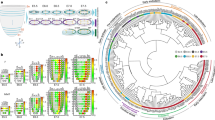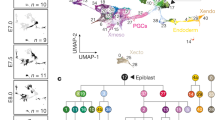Abstract
The diverse morphologies among vertebrate species stems from the evolution of a basic body plan that is constituted by a spatially organized ensemble of tissue lineage progenitors. At gastrulation, this body plan is established through a coordinated morphogenetic process and the delineation of tissue lineages that are driven by the activity of the genome. To explore the molecular mechanisms, in a comprehensive context, it is imperative to glean an understanding of the region- and population-specific genetic activity underpinning this fundamental developmental process. In this review, we outline the recent progresses and the future directions in studies of genome activity for the regulation of mouse embryogenesis at gastrulation.
Similar content being viewed by others
References
Alev, C., Wu, Y., Kasukawa, T., Jakt, L.M., Ueda, H.R., and Sheng, G. (2010). Transcriptomic landscape of the primitive streak. Development 137, 2863–2874.
Arendt, D., and Nübler-Jung, K. (1999). Rearranging gastrulation in the name of yolk: evolution of gastrulation in yolk-rich amniote eggs. Mechanisms Dev 81, 3–22.
Beddington, R.S. (1981). An autoradiographic analysis of the potency of embryonic ectoderm in the 8th day postimplantation mouse embryo. J Embryol Exp Morphol 64, 87–104.
Beddington, R.S. (1982). An autoradiographic analysis of tissue potency in different regions of the embryonic ectoderm during gastrulation in the mouse. J Embryol Exp Morphol 69, 265–285.
Beddington, R.S. (1994). Induction of a second neural axis by the mouse node. Development 120, 613–620.
Boward, B., Wu, T., and Dalton, S. (2016). Concise review: control of cell fate through cell cycle and pluripotency networks. Stem Cells 34, 1427–1436.
Cheng, X., Ying, L., Lu, L., Galvão, A.M., Mills, J.A., Lin, H.C., Kotton, D.N., Shen, S.S., Nostro, M.C., Choi, J.K., Weiss, M.J., French, D.L., and Gadue, P. (2012). Self-renewing endodermal progenitor lines generated from human pluripotent stem cells. Cell Stem Cell 10, 371–384.
Costello, I., Nowotschin, S., Sun, X., Mould, A.W., Hadjantonakis, A.K., Bikoff, E.K., and Robertson, E.J. (2015). Lhx1 functions together with Otx2, Foxa2, and Ldb1 to govern anterior mesendoderm, node, and midline development. Genes Dev 29, 2108–2122.
Dahl, J.A., Jung, I., Aanes, H., Greggains, G.D., Manaf, A., Lerdrup, M., Li, G., Kuan, S., Li, B., Lee, A.Y., Preissl, S., Jermstad, I., Haugen, M.H., Suganthan, R., Bjørås, M., Hansen, K., Dalen, K.T., Fedorcsak, P., Ren, B., and Klungland, A. (2016). Broad histone H3K4me3 domains in mouse oocytes modulate maternal-to-zygotic transition. Nature 537, 548–552.
Dalton, S. (2015). Linking the cell cycle to cell fate decisions. Trends Cell Biol 25, 592–600.
De Robertis, E.M., Fainsod, A., Gont, L.K., and Steinbeisser, H. (1994). The evolution of vertebrate gastrulation. Development 120 Supplement, 117−124.
Deglincerti, A., Croft, G.F., Pietila, L.N., Zernicka-Goetz, M., Siggia, E.D., and Brivanlou, A.H. (2016). Self-organization of the in vitro attached human embryo. Nature 533, 251–254.
Fang, H., Yang, Y., Li, C., Fu, S., Yang, Z., Jin, G., Wang, K., Zhang, J., and Jin, Y. (2010). Transcriptome analysis of early organogenesis in human embryos. Dev Cell 19, 174–184.
Green, R.M. (1995). Report of the human embryo research panel. Kennedy Inst Ethics J 5, 83–86.
Han, D.W., Tapia, N., Joo, J.Y., Greber, B., Araúzo-Bravo, M.J., Bernemann, C., Ko, K., Wu, G., Stehling, M., Do, J.T., and Schöler, H.R. (2010). Epiblast stem cell subpopulations represent mouse embryos of distinct pregastrulation stages. Cell 143, 617–627.
Hashimshony, T., Feder, M., Levin, M., Hall, B.K., and Yanai, I. (2015). Spatiotemporal transcriptomics reveals the evolutionary history of the endoderm germ layer. Nature 519, 219–222.
Kojima, Y., Kaufman-Francis, K., Studdert, J.B., Steiner, K.A., Power, M.D., Loebel, D.A.F., Jones, V., Hor, A., de Alencastro, G., Logan, G.J., Teber, E.T., Tam, O.H., Stutz, M.D., Alexander, I.E., Pickett, H.A., and Tam, P.P.L. (2014a). The transcriptional and functional properties of mouse epiblast stem cells resemble the anterior primitive streak. Cell Stem Cell 14, 107–120.
Kojima, Y., Tam, O.H., and Tam, P.P.L. (2014b). Timing of developmental events in the early mouse embryo. Semin Cell Dev Biol 34, 65–75.
Lawson, K.A., Meneses, J.J., and Pedersen, R.A. (1991). Clonal analysis of epiblast fate during germ layer formation in the mouse embryo. Development 113, 891–911.
Lawson, K.A., and Pedersen, R.A. (1987). Cell fate, morphogenetic movement and population kinetics of embryonic endoderm at the time of germ layer formation in the mouse. Development 101, 627–652.
Li, L., Song, L., Liu, C., Chen, J., Peng, G., Wang, R., Liu, P., Tang, K., Rossant, J., and Jing, N. (2015). Ectodermal progenitors derived from epiblast stem cells by inhibition of Nodal signaling. J Mol Cell Biol 7, 455–465.
Liu, X., Wang, C., Liu, W., Li, J., Li, C., Kou, X., Chen, J., Zhao, Y., Gao, H., Wang, H., Zhang, Y., Gao, Y., and Gao, S. (2016). Distinct features of H3K4me3 and H3K27me3 chromatin domains in pre-implantation embryos. Nature 537, 558–562.
Luo, S., Lu, J.Y., Liu, L., Yin, Y., Chen, C., Han, X., Wu, B., Xu, R., Liu, W., Yan, P., Shao, W., Lu, Z., Li, H., Na, J., Tang, F., Wang, J., Zhang, Y.E., and Shen, X. (2016). Divergent lncRNAs regulate gene expression and lineage differentiation in pluripotent cells. Cell Stem Cell 18, 637–652.
Martindale, M.Q. (2005). The evolution of metazoan axial properties. Nat Rev Genet 6, 917–927.
Mitiku, N., and Baker, J.C. (2007). Genomic analysis of gastrulation and organogenesis in the mouse. Dev Cell 13, 897–907.
Nakamura, T., Okamoto, I., Sasaki, K., Yabuta, Y., Iwatani, C., Tsuchiya, H., Seita, Y., Nakamura, S., Yamamoto, T., and Saitou, M. (2016). A developmental coordinate of pluripotency among mice, monkeys and humans. Nature 537, 57–62.
Parameswaran, M., and Tam, P.P.L. (1995). Regionalisation of cell fate and morphogenetic movement of the mesoderm during mouse gastrulation. Dev Genet 17, 16–28.
Peng, G., Suo, S., Chen, J., Chen, W., Liu, C., Yu, F., Wang, R., Chen, S., Sun, N., Cui, G., Song, L., Tam, P.P.L., Han, J.D.J., and Jing, N. (2016). Spatial transcriptome for the molecular annotation of lineage fates and cell identity in mid-gastrula mouse embryo. Dev Cell 36, 681–697.
Pfister, S., Steiner, K.A., and Tam, P.P.L. (2007). Gene expression pattern and progression of embryogenesis in the immediate post-implantation period of mouse development. Gene Expr Patterns 7, 558–573.
Rodaway, A., and Patient, R. (2001). Mesendoderm. an ancient germ layer? Cell 105, 169–172.
Rossant, J., and Tam, P.P.L. (2009). Blastocyst lineage formation, early embryonic asymmetries and axis patterning in the mouse. Development 136, 701–713.
Scialdone, A., Tanaka, Y., Jawaid, W., Moignard, V., Wilson, N.K., Macaulay, I.C., Marioni, J.C., and Göttgens, B. (2016). Resolving early mesoderm diversification through single-cell expression profiling. Nature 535, 289–293.
Shahbazi, M.N., Jedrusik, A., Vuoristo, S., Recher, G., Hupalowska, A., Bolton, V., Fogarty, N.M.E., Campbell, A., Devito, L.G., Ilic, D., Khalaf, Y., Niakan, K.K., Fishel, S., and Zernicka-Goetz, M. (2016). Self-organization of the human embryo in the absence of maternal tissues. Nat Cell Biol 18, 700–708.
Sheng, G. (2015). Epiblast morphogenesis before gastrulation. Dev Biol 401, 17–24.
Snow, M. (1977). Gastrulation in the mouse: growth and regionalization of the epiblast. J Embryol Exp Morphol 42, 293–303.
Solnica-Krezel, L. (2005). Conserved patterns of cell movements during vertebrate gastrulation. Curr Biol 15, R213–R228.
Solnica-Krezel, L., and Sepich, D.S. (2012). Gastrulation: making and shaping germ layers. Annu Rev Cell Dev Biol 28, 687–717.
Takaoka, K., and Hamada, H. (2012). Cell fate decisions and axis determination in the early mouse embryo. Development 139, 3–14.
Tam, P.P. (1989). Regionalisation of the mouse embryonic ectoderm: allocation of prospective ectodermal tissues during gastrulation. Development 107, 55–67.
Tam, P.P., and Beddington, R.S. (1987). The formation of mesodermal tissues in the mouse embryo during gastrulation and early organogenesis. Development 99, 109–126.
Tam, P.P.L., and Behringer, R.R. (1997). Mouse gastrulation: the formation of a mammalian body plan. Mech Dev 68, 3–25.
Tam, P.P.L., and Loebel, D.A.F. (2007). Gene function in mouse embryogenesis: get set for gastrulation. Nat Rev Genet 8, 368–381.
Tam, P.P.L., Loebel, D.A.F., and Tanaka, S.S. (2006). Building the mouse gastrula: signals, asymmetry and lineages. Curr Opin Genet Dev 16, 419–425.
Tam, P.P.L., Williams, E.A., and Chan, W.Y. (1993). Gastrulation in the mouse embryo: ultrastructural and molecular aspects of germ layer morphogenesis. Microsc Res Tech 26, 301–328.
Tang, F., Lao, K., and Surani, M.A. (2011). Development and applications of single-cell transcriptome analysis. Nat Meth 8, S6–S11.
Tang, W.W.C., Kobayashi, T., Irie, N., Dietmann, S., and Surani, M.A. (2016). Specification and epigenetic programming of the human germ line. Nat Rev Genet 17, 585–600.
Viotti, M., Nowotschin, S., and Hadjantonakis, A.K. (2014). SOX17 links gut endoderm morphogenesis and germ layer segregation. Nat Cell Biol 16, 1146–1156.
Wang, L., and Chen, Y.G. (2016). Signaling control of differentiation of embryonic stem cells toward mesendoderm. J Mol Biol 428, 1409–1422.
Wells, J.M., and Melton, D.A. (1999). Vertebrate endoderm development. Annu Rev Cell Dev Biol 15, 393–410.
Wen, L., and Tang, F. (2014). Reconstructing complex tissues from singlecell analyses. Cell 157, 771–773.
Wolpert, L. (1992). Gastrulation and the evolution of development. Development 116 Supplement, 7−13.
Wu, J., Huang, B., Chen, H., Yin, Q., Liu, Y., Xiang, Y., Zhang, B., Liu, B., Wang, Q., Xia, W., Li, W., Li, Y., Ma, J., Peng, X., Zheng, H., Ming, J., Zhang, W., Zhang, J., Tian, G., Xu, F., Chang, Z., Na, J., Yang, X., and Xie, W. (2016). The landscape of accessible chromatin in mammalian preimplantation embryos. Nature 534, 652–657.
Zhang, B., Zheng, H., Huang, B., Li, W., Xiang, Y., Peng, X., Ming, J., Wu, X., Zhang, Y., Xu, Q., Liu, W., Kou, X., Zhao, Y., He, W., Li, C., Chen, B., Li, Y., Wang, Q., Ma, J., Yin, Q., Kee, K., Meng, A., Gao, S., Xu, F., Na, J., and Xie, W. (2016). Allelic reprogramming of the histone modification H3K4me3 in early mammalian development. Nature 537, 553–557.
Zhu, Q., Song, L., Peng, G., Sun, N., Chen, J., Zhang, T., Sheng, N., Tang, W., Qian, C., Qiao, Y., Tang, K., Han, J.D.J., Li, J., and Jing, N. (2014). The transcription factor Pou3f1 promotes neural fate commitment via activation of neural lineage genes and inhibition of external signaling pathways. eLife 3, e02224.
Acknowledgements
We apologized to authors whose works have not been cited here because of space limitation. This work was supported by the “Strategic Priority Research Program” of the Chinese Academy of Sciences (XDA01010201), National Key Basic Research and Development Program of China (2014CB964804, 2015CB964500), and National Natural Science Foundation of China (31430058, 31571513, 31630043, 91519314).
Author information
Authors and Affiliations
Corresponding authors
Rights and permissions
About this article
Cite this article
Peng, G., Jing, N. The genome-wide molecular regulation of mouse gastrulation embryo. Sci. China Life Sci. 60, 363–369 (2017). https://doi.org/10.1007/s11427-016-0285-3
Received:
Accepted:
Published:
Issue Date:
DOI: https://doi.org/10.1007/s11427-016-0285-3




